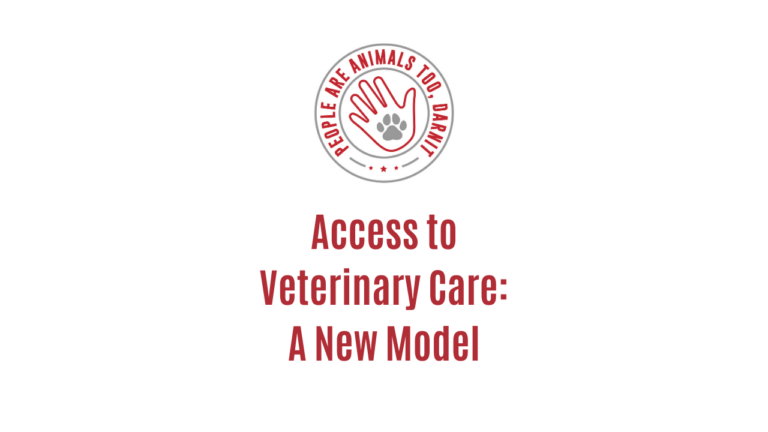Embracing an approach that helps the public, veterinarians and animal shelters
About 85 million households have pets in the United States, according to the most recent American Pet Products Association Survey. But not all of them have adequate access to veterinary care. Nearly 40 million pets live in households where the annual income is under $45,000.
Cost is one of the biggest factors that prevents people from getting veterinary care for their pets, as well as location—having a clinic close enough that they can easily access it, especially if they have to use public transportation.
“This really is a problem for millions of people,” said Aimee St. Arnaud, director of national veterinary outreach for Best Friends Animal Society. “It’s a national crisis. I think it’s a social justice issue.”
However, running a veterinary practice is expensive, and veterinarians can’t just lower their prices. So St. Arnaud, along with business partners, set out to create veterinary practices—one in Ohio and one in North Carolina—that not only had a sustainable business model, but increased access to veterinary care. It worked.
Now St. Arnaud and Dr. Sara Pizano, a veterinarian with Team Shelter USA, are working on a national training program that shows communities how to implement this model to increase access to veterinary care across the country. They discussed their work with Panhandle Animal Shelter Executive Director Mandy Evans on her podcast, “People Are Animals Too, Darnit!”
The Role of Animal Shelters and Private Practice Veterinarians
We’ve already established that access to veterinary care, especially in terms of cost, is an issue for individuals. When individuals can’t pay their veterinary bills, pets end up at animal shelters. Therefore, animal shelters have a vested interest in trying to increase access to care.
Unfortunately, asking veterinarians to lower their prices isn’t the solution, and it’s unfair to expect them to lower their prices. Costs of running a veterinary practice are going up, and private practice veterinarians are business owners who have invested a lot in their work and need to support their practices and employees.
But veterinarians also have an incentive to increase access to care. They’ll be able to help more animals and their community without taking a financial hit. They’ll also get more clients, instead of having people turn down care because they can’t afford it.
Unfortunately, animal shelters and veterinarians don’t historically have the best relationships.
From the veterinarians’ perspectives, animal shelters might be asking for a lot, like discounts or appointments when the clinic is full, said Pizano.
On the other hand, veterinarians might not fully realize the situation animal shelters are in—like how many animals they take in or their limited budgets.
Pizano explains that a shelter she used to work at took in more than 37,000 animals a year.
“I met veterinarians in that community that were there for more than 30 years practicing, and they had no idea,” she said.
It’s key for animal shelters and veterinarians to communicate, so they can work together. That’s where the new model comes in.
“All we’re trying to do is help them be able to say yes more than no in terms of when someone does need financial assistance, but also still be able to make sure they’re covering their costs,” said St. Arnaud.
Animal Shelters and Veterinarians Working Together
The new model not only has animal shelters and private veterinary practices working together, but includes human services providers as well, usually social workers.
Here’s how it can work: Animal shelters run outreach programs to members of the community that might lack access to veterinary care. Social workers can refer their clients to the shelter or veterinarian. Shelters work with private practice veterinarians so they can help fund care for clients. There are endless ways they can work together, but one example is by setting up a medical fund for use at the veterinary clinic.
There are also other policies and practices veterinarians can implement that help lower costs.
One example of this is incremental care, which is a step-by-step approach, said St. Arnaud.
Instead of running full diagnostics and blood work right away when a pet comes in (which is costly), veterinarians might try one antibiotic or other solution first, to see if it works. If it doesn’t, they try something else.
St. Arnaud and her team have also figured out various efficiencies that allow veterinarians to do their work without taking a financial hit, she said.
“It is definitely going to be a challenge and not all communities are ready for it but … I really do believe there are enough people who are ready for this right now that we’re going to see great progress and get the naysayers on board,” said St. Arnaud.
Steps Animal Shelters Can Take to Get Started
To get started, animal shelters can set up a meeting with local veterinarians. Look at your data, and see what issues you’re seeing a lot of. For example, if it’s parvo, maybe do outreach or a joint vaccine program—and get the media to cover it, said St. Arnaud.
Keep talking regularly and come up with ideas.
“Really I think it’s about how you can help each other, and a lot of times it’s just learning the data, finding where the commonalities are, what you are both struggling with and coming up with a solution together,” said St. Arnuad.
Consider putting together a pet resource guide, like where pet food banks, low cost are. Ask veterinarians to hand that out to clients.
Spread the word about what you’re doing by going to local veterinary association meetings and getting to know local veterinarians, said Pizano.
Overall, with this new model of veterinary care, working together is key. It will help people, their pets, veterinarians and shelters.
“It’s marrying all of these needs and really changing the way we practice veterinary medicine,” said Pizano. “So it’s definitely a culture shift for the industry, and one that in my opinion that can only get better.”

